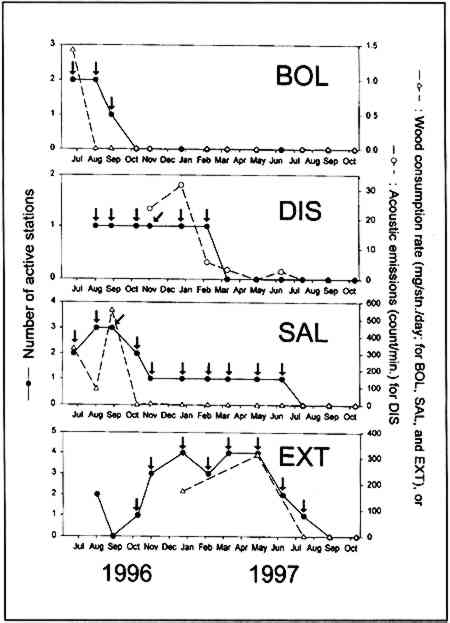ELIMINATION OF SUBTERRANEAN TERMITE POPULATIONS FROM THE STATUE OF LIBERTY NATIONAL MONUMENT USING A BAIT MATRIX CONTAINING AN INSECT GROWTH REGULATOR, HEXAFLUMURONNAN-YAO SU, JAMEY D. THOMAS, & RUDOLF H. SCHEFFRAHN
5 EFFECTS OF BAIT APPLICATION ON FOUR CLUSTERS OF TERMITE ACTIVITYAs shown in fig. 1, four clusters of subterranean termite activity were identified in the two ground floors of the pedestal of the monument: the boiler room (BOL); a display case in the second-floor museum area (DIS); the sally port (SAL); and the sally port exit (EXT). Because of the complexity of the structures where termites were found, baits containing 0.5% hexaflumuron were applied using all available delivery methods including soft-style above-ground bait stations (AGS), hard-style above-ground bait stations (AGH), and in-ground Sentricon stations (S) (see fig. 2). 5.1 BOILER ROOM (BOL)Termites were found in foraging tubes and earthen works on the wall joints of the boiler room, indicating a soil-borne origin of this population (fig. 1). Old foraging tubes were also found on the floor-wall interface and on the interior of the pedestal walls (see triangles, fig. 1). Termites found in the boiler room were probably interconnected with those detected in soil near the boiler room exterior wall because of the numerous underground utility pipes leading to the outdoor cooling facility. Subterranean termites are known to be attracted to water condensation on cooling pipes, and the warmer microclimate near the heating pipes may also harbor termites during winter. By early July 1996, termites infested one in-ground monitoring station (T1) and one Sentricon station (S1) (see fig. 1). One bait tube containing hexaflumuron was placed in S1. In mid-July, however, National Park Service personnel doing maintenance work inadvertently excavated both stations. In August, one above-ground monitoring station (AGM5) and one bait station (AGS4) were placed over the foraging tubes containing live termites (see fig. 1). The entire 15 g of bait matrix in AGS4 was consumed in September; no termite was found in any of the stations inside or outside the boiler room (fig. 4). Termites did not fly in the boiler room in spring 1997 or 1998. We concluded that population BOL was eliminated after consuming 142 mg of hexaflumuron in three months (table 1).
TABLE 1. SUMMARY OF HEXAFLUMURON BAIT APPLICATION TO CONTROL SUBTERRANEAN TERMITE POPULATIONS IN STATUE OF LIBERTY NATIONAL MONUMENT 5.2 DISPLAY CASES (DIS)On the northeastern end of the second floor, old foraging tubes were found on the museum floor and inside the display cases (see triangles, fig. 1). Termites had swarmed there in spring 1994, 1995, and 1996. Some wooden floors were so extensively damaged that they had to be replaced. Live termites were found in foraging tubes inside the display cases (see fig. 3). In August 1996, one above-ground soft station was placed beneath the display cases over foraging tubes containing live termites (see fig. 3). The entire 15 g bait matrix was consumed from this station (see AGS13, fig. 1) within a month. Two double stations (two stations stacked over each other, 30 g matrix total) were added in September and October, and both were totally consumed. In November, termite feeding activity was detected using the acoustic emission device from the wooden floor of the display area (see fig. 4). Two additional bait stations (see AGS16 5.3 SALLY PORT (SAL)In the sally port, foraging tubes and earthen works containing live termites were found in the wall joints and between the concrete floor and the stone walls of the original fortress. One hard-style (AGH10) and one soft-style (AGS11) above-ground bait station and one above-ground monitoring station (AGM12) were placed over the active foraging tubes in July 1996 (see figs. 1, 4). A considerable amount of bait was consumed from both AGH10 and AGS11 from July to September. By October, termite activity in the monitoring station AGM12 declined sharply (see fig. 4), but termites continued to feed on bait in both above-ground bait stations, AGH10 and AGS11. In November, termite feeding in AGH10 ceased. Termites continued feeding in the bait station AGS11 through winter 1996 and spring 1997, only less vigorously than in previous months. By May and June 1997, only a few termites were found in AGS11. All termites exhibited marbled coloration, which is the secondary symptom of hexaflumuron effects (Su et al. 1996). In July, only springtails (Insecta: Collembola) were found in AGS11. Collembolans feed on decaying material and fungi. The presence of such decomposers and scavengers in termite galleries usually implies the demise of the termite colony. We believe the termite population in sally port was eliminated after consuming 915 mg hexaflumuron during the 11-month baiting period (see table 1). 5.4 SALLY PORT EXIT (EXT)In summer 1996, one wooden stake near the sally port exit detected termite activity and was replaced by an in-ground monitoring station (see T3, fig. 1). Termites were seen in T3, but feeding on the wooden block was not vigorous throughout 1996 (see fig. 4). Termites were found in one of the Sentricon stations (S13) placed near T3, and hexaflumuron bait was placed in October. Despite the cold weather, termites remained active through winter 1996 and spring 1997 (see fig. 4). By March 1997, termites were found in three Sentricon stations (S11, S13, and S14) into which hexaflumuron baits were placed (see fig. 1). Termites fed extensively on the wooden block in T3 during spring 1997. By June, termites found in T3 were lethargic and exhibited marbled coloration. Termite activity in T3 declined to zero in July (see fig. 4). Feeding on hexaflumuron baits in Sentricon stations continued in June and July, but termites found in these stations were also visibly affected by hexaflumuron, i.e., they were lethargic and had marbled coloration. By September, no termite was found in any of the Sentricon or monitoring stations. The nine-month baiting, during which 200 mg of hexaflumuron was consumed, apparently eliminated the EXT population (see table 1, p. 292). |
